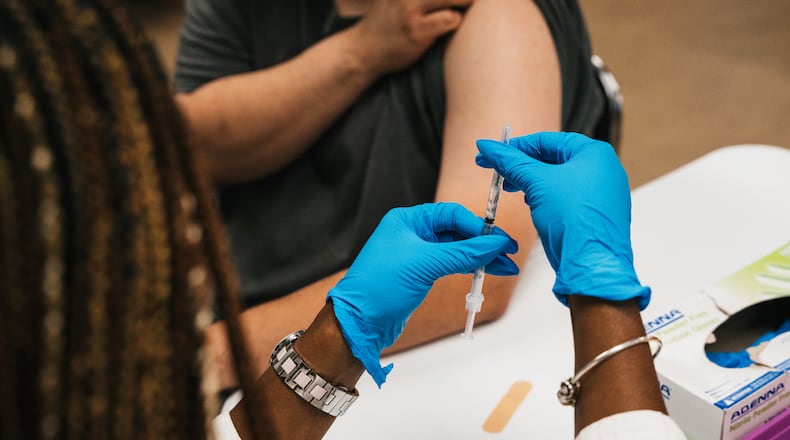“Let’s do prevention before we get into a crisis,” said Dr. Rhea Rowser, a Kettering Health primary care doctor. “We know that the vaccine works.”
The updated CDC recommendations for the COVID vaccine say everyone ages 6 months and older should receive an updated 2024-2025 COVID-19 vaccine this fall. This simplifies the previous instructions from last fall that included different time tables and varying numbers of shots depending on when previous shots were received and the ages of the patients.
Updated COVID-19 vaccines will be available from Moderna, Novavax and Pfizer later this year, the CDC says. This recommendation will take effect as soon as the new vaccines are available.
In Montgomery County, 11.51% of the population got the most recent COVID vaccine, compared to 12.07% in Greene County and 9.54% in Clark County, according to data from the Ohio Department of Health. The county with the lowest percentage of residents who got the latest vaccine was Preble County with only 6.73%.
In Butler County, 9.75% of the population got the most recent COVID vaccine, and 11.87% of Warren County got the vaccine.
Nationwide in 2023, more than 916,300 people were hospitalized due to COVID-19 and more than 75,500 people died from COVID-19, the CDC says. During the 2023-2024 flu season, more than 44,900 people are estimated to have died from flu complications, also according to the CDC.
“Our top recommendation for protecting yourself and your loved ones from respiratory illness is to get vaccinated,” said CDC director Dr. Mandy Cohen. “Make a plan now for you and your family to get both updated flu and COVID vaccines this fall, ahead of the respiratory virus season.”
COVID is continuing to spread now in Ohio, though doctors are not seeing the severity of symptoms from previous strains.
“Over the last couple of weeks, we have even seen an increase of COVID in our office,” Rowser said.
Patients would come in, suspecting a sinus infection, but they found it was actually COVID, she said.
The symptoms doctors are seeing are more related to sinuses, as well as body aches, headaches and congestion, she said.
“It’s looking more like the flu or an upper respiratory tract infection, so we’re not seeing the intense symptoms that we were seeing early on,” Rowser said.
Ohio reported 83 hospitalizations related to COVID over the last week, up from the three-week average of 72. One ICU admission was reported and eight deaths were reported over the last week, which is not a change over the three-week average, according to data from the Ohio Department of Health.
Nationwide, 0.9% of emergency room visits are diagnosed as COVID, according to the CDC. While a small percentage, this is an increase of 23.3% in the most recent week.
Hospitalizations have not increased or decreased over the most recent week with 1.5 hospitalizations related to COVID being reported per 100,000 people, the CDC says.
COVID-related deaths make up 0.8% of deaths in the U.S. currently, which is an increase of 14.3% over the most recent week.
“You’re still seeing COVID out there, so you still need to protect yourself against it, just like you do the flu,” Rowser said.
Everyone 6 months of age and older should get an updated flu shot this fall as well, the CDC says. The CDC is encouraging health care providers to begin their influenza vaccination planning efforts now and to vaccinate patients once 2024-2025 influenza vaccines become available.
September and October remain the best times for most people to get vaccinated, the CDC says.
“It’s right around the corner. We’re already in July,” Rowser said.
Flu vaccination in July and August is not recommended for most people, but there are several considerations regarding vaccination during those months for specific groups, such as certain young children who qualify for two doses of the flu vaccine.
Pregnant people who are in their third trimester can get a flu vaccine in July or August to protect their infants from flu after birth, when they are too young to get vaccinated, the CDC says.
The CDC also updated its recommendations for RSV vaccinations for adults, changing the previous recommendation that people 60 and older get the RSV vaccine to saying people 75 and older should get the vaccine.
“The CDC has updated its RSV vaccination recommendation for older adults to prioritize those at highest risk for serious illness from RSV,” Mandy Cohen said. “People 75 or older, or between 60-74 with certain chronic health conditions or living in a nursing home should get one dose of the RSV vaccine to provide an extra layer of protection.”
About the Author

